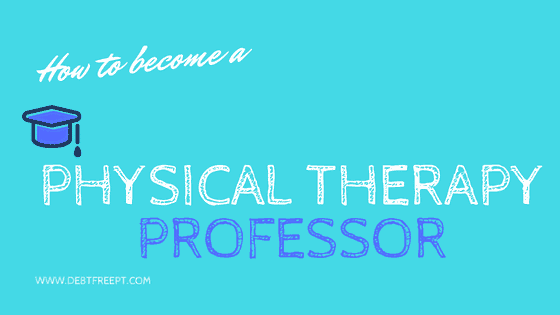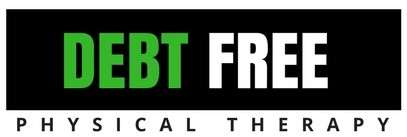How to Become a Physical Therapy Professor
by DebtFreeEmma | Nov 12, 2017


How to Become a Physical Therapy Professor
Physical therapy, like many other medical professions, is a demanding career. Physical therapists (PTs) are required to be organized, outgoing, on their feet 90% of the time, and perform extensive documentation. Not only are PTs are on their feet, but they are often required to perform very physical tasks such as transferring, massaging, and stretching patients. Trust me, after holding a 300lb man’s leg for 2min in the air for stretching, I’m exhausted!
It is not surprising that many therapists are feeling burnt out by this exhausting career, and are looking for alternatives to use their physical therapy degree but not have to have the burdens of heavy documentation or lifting heavy patients.
One of the first jobs that come to mind when I think about switching physical therapy career paths is teaching. As a physical therapy faculty member, you would have the chance to influence the future of physical therapy and future physical therapists! In addition, many faculty members are able to perform clinical work or research as well as teach- enabling a more diverse work day. Teaching could provide a break from the physical demands and fast paced environment of clinical PT.
I recently interviewed a physical therapy faculty recruiter from an accredited physical therapy university to ask her how to become a physical therapy professor!
Common Requirements: Below are some of the common requirements to become a physical therapy faculty member.
-
Doctor of Physical Therapy Degree. May substitute a masters degree if willing to obtain doctorate level at a later date.
-
Doctorate in Education or in Public Health or Administration also preferred.
-
At least 3 years of clinical physical therapy experience.
-
Teaching experience preferred. It is important to note that this is not limited to being a faculty member. Performing guest lectures, seminars, continuing education classes all are great ways to break into the world of academia according to my interview.
-
Online experience and knowledge. With today’s growing need for social media marketing, it is ideal that a professor also have some knowledge and comfort with various technology including online teaching, marketing, and social media.
-
Passion for the physical therapy profession and a passion for teaching. This is a bit of no brainer, anyone who is going into teaching should want to actually teach! In addition, many schools want professors who are involved in the community at their university. This involvement could be serving committees or providing volunteer physical therapy efforts or even mentoring and tutoring students.
-
Passion for learning. At the university I spoke with, they required their teachers to also spend time learning and improving their knowledge. The physical therapy world is rapidly changing. Healthcare rules and regulations are often being altered and new modalities or treatment evidence is being published. Demonstrating your willingness to advance your PT knowledge could set you apart from fellow applicants.
Typical Therapy Faculty Member Salary
Therapy professors initially earn roughly the same wages a permanent positions, in the $60,000 to $80,000 range depending on experience, speciality certifications or additional degrees, and research experience.
Although this salary is not as enticing as other career options, think of the bonuses that come with teaching. You would be required to perform less paperwork, less lifting and physical labor, and yet still use your PT degree.
How to Increase A PT Professor’s Salary:
Although a therapist’s teaching salary may not sound perfect, there is room to grow finically as a therapy faculty member. You can increase your earnings by:
–Getting tenure. Just as with most positions, the longer you work-the more money you will earn.
-Having published research articles. Publishing articles helps increase your’ schools ranking amongst other schools as well increase their credibility and hopefully gain funding for future research. All of these things lead to more money for the PT school and hopefully for you as well.
-Obtaining research grants or federal funding to help fund further research programs. The federal government and even some private organizations providing funding in the form of grants to aid research programs. Showing your ability to help provide funding for the school you work for is very valuable and should lead to increased compensation.
-Working as a clinician as well as faculty member. Many programs such as USC (University of Southern California) allow therapists to work and teach at the same time. For example, one professor may teach classes once a semester on Tuesday and Thursday and then work at the affiliated hospital (for USC that is their Keck Medical Center or USC Outpatient Facility) and Monday, Wednesday and Friday.
-Creating unique programs for your employer/graduate school. Anytime you can show your ability to grow the graduate program is a way for the school to make more money. You ability to grow the school to lead to increased salary negotiation power or opening up new roles for you as a faculty member
-Switch from teaching to chair member or administrative positions for the graduate program or school. Once you gain traction as a professor, you could more into often higher paying positions such as administrative positions.
Typical Day:
Different universities will have various daily requirements for their faculty members. As a result, the day of one professor could look completely different from other members of the university. While I cannot guarantee that all programs will be the same, I can provide one example. Here is the example work day that I was provided when I interviewed a potential physical therapy graduate school for a full time faculty position:
Sample: 40 Hour Work Week
-
20 hours: Teaching various classes
-
8 hours: Learning and advancing your knowledge. This could be continuing education classes, get certifications, even studying for additional degrees such as your education degree.
-
8 hours: Committee work. This would be volunteer or social service committees that the students participate in, mentorship/tutoring, any committee that helps grow the physical therapy program and the students at the university.
-
8 hours: Clinical work or research.

How are the classes structured?
Every University will be different in the structure of their program. However, to keep standardization across classes and across previous years, programs often have lectures pre made. I was nervous about how to start making a class; how to start the power points and the lectures! So its pretty awesome that you could be teacher and have the class already set up for you. However, you still have to answer student questions off the cuff. You would also have to be able to interpret the slides and explain them if the class was struggling with a concept. A good professor also would be able to add their own experiences to the slides to help create relatable information. But overall, class set up doesn’t sound too bad! I assume that the first several years of teaching are the most difficult, but as you learn the lectures it likely becomes pretty routine.
Research Earns Faculty More Money
Ironically, in the interview, performing research actually helped advance your teaching career. Research actually brings money into the University. As a result, if you can be lucky enough to get a grant for your research project, then this helps the University make more money and pay for you and your co-worker’s salaries!
How Do I Start Working As A PT Professor:
It may difficult to get a teaching position as a new or recent graduate. Here are some of the best ways to to make your resume standout and help you start your teaching career:
One: Guest Lecture
Two: Perform Continuing Education Classes or Seminars
Three: Start a social media profile that helps solve various physical therapy problems. Creating a following will show that you can teach and gain the interest of your peers.
Four: Tutor physical therapy at your desired campus or in general for future or current PT students.
Summary:
Overall, being a PT faculty member sounds pretty great. It seems that the day is diverse and that there is room to grow both in one’s education/knowledge but also in the teaching career. There is also a potential for upwards growth for your salary.
If you are interested in becoming a faculty member, it seemed that starting out as a guest lecturer was the best route to work into academic program. Guest lecture takes little time and risk compared to the other options and is something you can do quickly and easily.
Looking for different careers as a physical therapist?
TRAVEL HEALTHCARE BASICS:
Looking to save or make more money as a physical therapist?







